LESBOS
Plants and Animals

Plants and Animals

Popular destinations GREECE
| Aegina | Alonissos | Andros |
| Chios | Corfu | Crete |
| Hydra | Kalymnos | Karpathos |
| Kefalonia | Kos | Lefkas |
| Lesbos | Mykonos | Naxos |
| Paros | Patmos | Peloponnese |
| Poros | Rhodes | Samos |
| Santorini | Skiathos | Skopelos |
| Spetses | Thasos | Zakynthos |
Plants and Animals
Plants
The flora of Lesbos, which belongs to the Mediterranean evergreen zone, has about 1250 species, including 70 species and subspecies of orchids. The great variety is due to the great differences on the island in terms of climate, soil conditions, altitude and number of hours of sunshine. The west is considerably drier and calmer than the wetter, calcareous east, and this is reflected in the flora. In the dry west there are hardly any forests left and the hills are covered with low bushes.
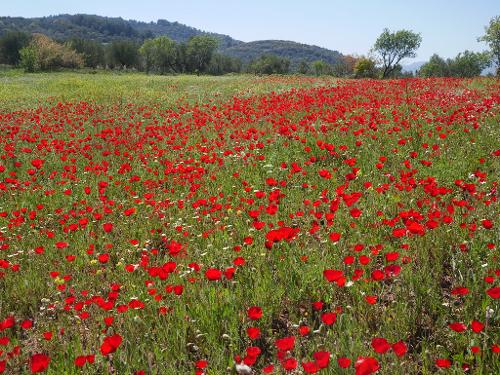 Poppy Fields in LesbosPhoto: Frank Vassen CC 2.0 no changes made
Poppy Fields in LesbosPhoto: Frank Vassen CC 2.0 no changes made
A large part of Lesbos consists of small-scale cultivated landscape, where there is still enough space for trees, plants and flowers. In vast olive orchards and fields grow cornflowers, gladioli, camomile and poppies. Road verges and meadows have a varied vegetation with, among others, the purple mirrorbell, which has become very rare. Along the water's edge, yellow horned poppy grows. On the uncultivated slopes, a Mediterranean vegetation with cistus rose, sage and thyme can be found.
Wild endemic plant species, which only occur on Lesbos, are Alyssum lesbiacum, Alyssum xiphocarpum, Asperula nitida, Festuca pseudosupina and Ophrys bucephila.
Animals
Lesbos is one of the richest and most important Greek islands in terms of fauna. The island has great biodiversity, mainly due to its geographical location between two continents, Europe and Asia. Lesvos also has a great variety of ecosystems that are in good condition, including cultivated landscapes, marshes, pine forests and deciduous forests.
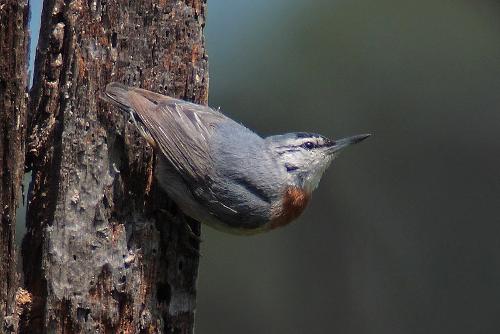 Nuthatch, LesbosPhoto: Mark S Jobling CC 3.0 no changes made
Nuthatch, LesbosPhoto: Mark S Jobling CC 3.0 no changes made
The fauna of the island is composed of both European and Asian species due to its proximity to Asia Minor. Mammals, such as the Persian or Caucasian squirrel, reptiles, such as the Eurasian adder, and birds, such as the Turkish nuthatch, belong to the fauna of Asia Minor and, as far as Greece is concerned, are found only on Lesbos.
Thirteen species of land mammals have been observed on Lesbos, 11 species of bats, 5 amphibians and 21 reptiles. The bird fauna of the island is very important, with a number of wetlands very favourable for birds, such as the Kalloni and Geras Bay and the Polichnitos saltpans. A total of 325 bird species have been seen on the island.
Amphibians and reptiles
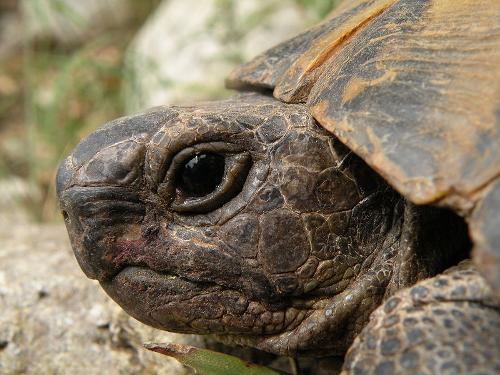 Moorish Turtoise, LesbosPhoto: Moise Nico CC 3.0 no changes made
Moorish Turtoise, LesbosPhoto: Moise Nico CC 3.0 no changes made
The herpetofauna of Lesbos is very rich for such a small island with two tortoises, the Moorish tortoise and the loggerhead (also called helmeted tortoise or bell-shaped tortoise) two bog turtles (including the Caspian the Caspian Sea Turtle), six lizards, including the Asian serpentine-eyed lizard, the harpoon, the giant spotted lizard, the scheltopusik, and eleven species of snakes, six of which are of Asian origin, Among them are the necklace snake and the Eurasian adder, as well as the dice snake, the slender worm snake, the striped tern snake, the sand boa, the spotted whorker snake, the slender whorker snake, the arrow snake and the lizard snake. Protected animals are the Moorish tortoise, the European pond terrapin, the Balkan stream tortoise and the leopard snake. Amphibians include the common green frog, tree frog and green toad.
Insects
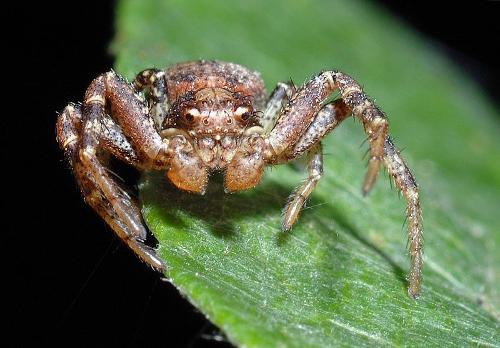 Crab Spider, LesbosPhoto:André Karwath aka Aka CC 2.5 no changes made
Crab Spider, LesbosPhoto:André Karwath aka Aka CC 2.5 no changes made
Lesbos is home to many insect species, including the gall wasp, the spring dung beetle, the bush locust, the loam wasp and the ground bug. Lesbos is also rich in spiders, including the crab spider and the fire-thrower.
Birds
Lesbos is a very interesting island for ornithologists. The geographical position of the island makes it a very important staging post for migratory birds. Some rare bird species have been observed in the various habitats of the island. A total of approximately 325 bird species have been observed on Lesbos.
The most important ecosystems for the birds of Lesbos are probably the wetlands. The most important of these are the two large bays on the island, Kaloni Bay and Geras Bay. The Kaloni and Polichnitos salt pans also attract a wide variety of birds as does the river at Skala Eressos. Lesbos has many springs and it rains enough to provide water for the many birds throughout the year.
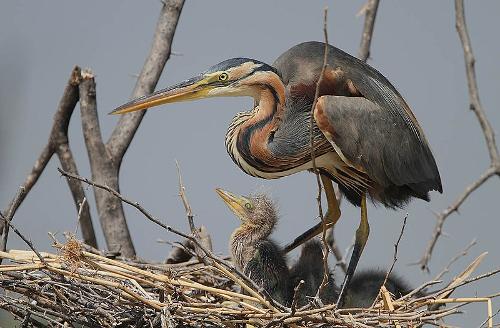 Purple Heron, LebosPhoto: Steve Garvie CC 2.0 no changes made
Purple Heron, LebosPhoto: Steve Garvie CC 2.0 no changes made
Lesbos has three protected areas and Kaloni Bay is one of them with about 68 bird species. The second area includes Geras Bay, the Dipi marsh and Mount Olympos, with protected animals such as the purple heron, the stork, the casarca (orange-brown-necked goose) and the Rüppell's warbler. The third area is the western peninsula where the petrified forest can be found near the villages of Sigri, Adissa and Eressos. Three protected bird species can be found in this area: the Rüppell's warbler, the Turkish tree viper and the Smyrna bunting, which can also be found in the mountains around Eressos.
Mammals
Lesbos has a great diversity of small mammals. For three of them, Lesbos is the only place in Europe where they can still be found and, what is more, they are found only on Mount Olympus. They are the Caucasus squirrel or Persian squirrel, a species of shrew from the genus Crocidura. Other mammals found on Lesbos are the western blind mouse, stone marten, weasel, brown rat, black rat, house mouse and wood shrew.
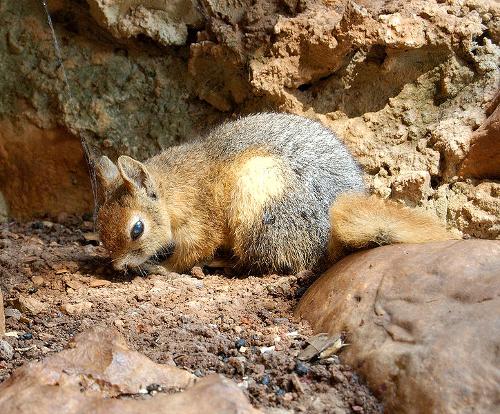 Caucasus Squirrel, LesbosPhoto: Peripitus CC 3.0 no changes made
Caucasus Squirrel, LesbosPhoto: Peripitus CC 3.0 no changes made
There are six protected species of bat on Lesbos: Lesser horseshoe bat, greater horseshoe bat, Blasius' horseshoe bat, lesser pallid bat, greater pallid bat and Schreiber's bat.
Sources
Dubin, Marc S. / Griekse eilanden
Van Reemst
Greek islands
Lonely Planet
Griekse eilanden
Lannoo
McGilchrist, Nigel / Greece : the Aegean islands
Somerset Books
Midgette, Anne / Griekse eilanden : Egeïsche Zee
Het Spectrum
CIA - World Factbook
BBC - Country Profiles
Copyright: Team The World of Info